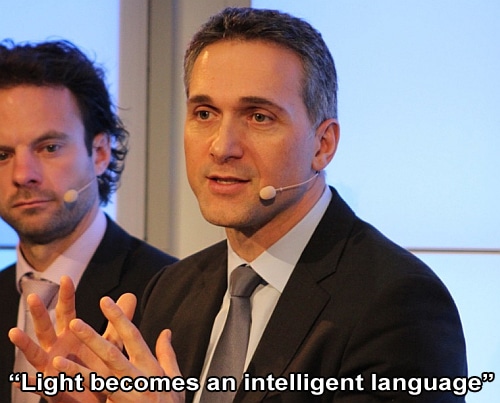What?
Have you ever had a volunteer come to your door with a free compact fluorescent lamp? When my wife and I lived in Oklahoma City, a community program volunteer brought a free compact fluorescent lamp to our house for us to have and use in order to save energy. How nice, right? We thought so. A public utility, FirstEnergy in Ohio, set up a program (that was approved by the Ohio Public Utilities Commission, by the way) that distributes compact fluorescent lamps to customers in Ohio.
Cool program, right? Free fluorescent lamps for all. Except they’re not free – FirstEnergy will be charging their customers $10.80 each for the lamps, automatically, with no opt-out program. Hold on a minute – for $10 I can go down to Target, Home Depot, or Lowes’ and buy a half-dozen compact fluorescent lamps. What’s with this $10.80 per lamp crap?
Last year, the Ohio state government passed a bill saying that utilities had to cut their customers’ usage 22% by the year 2025. Apparently this is how FirstEnergy is going about reducing energy usage – by charging customers way, way too much for something that people can buy on their own for 1/6 the price.
An article from John Funk at the Plain Dealer in Cleveland states:
FirstEnergy bought Chinese-made bulbs from three distributors including TCP Inc. of Aurora, because it couldn’t find any made in the United States. A California company will deliver 3 million of them door-to-door to Illuminating Co., Ohio Edison and Toledo Edison customers. The rest will be mailed.
Passing out the bulbs is not the way to persuade people to use them, Migden-Ostrander said. The company should have given its customers discount coupons and let them shop for the best deal, she said.
The company’s lawyers resisted that, arguing that FirstEnergy had to begin cutting back power deliveries right away to meet the terms of the new law.
Hmm. You know what really sucks about this? If you have seen the letter from FirstEnergy VP of Customer Service John Paganie, it seems like they’re giving these lamps away for free:
We are pleased to provide you with two energy-efficient CFLs. When you install these bulbs in place of two 100-watt incandescent bulbs in your home, you could save about $30 over the life of each bulb. Here’s how:
Traditional incandescent bulbs cost less to buy than CFLs, but they might only last 750 hours. Your new CFLs should last 10,000 hours, which is 10 times as long. This means you would need to buy more than 13 traditional bulbs to equal the lifespan of one CFL.
Also, your new CFLs will use 75 percent less electricity than a standard 100-watt incandescent bulb, and will produce the same amount of light. When you combine the longer life and decreased energy usage of the CFL, you can see significant, long-term savings for each bulb you replace.
FirstEnergy’s Ohio utility companies — The Illuminating Company, Ohio Edison and Toledo Edison — are providing these light bulbs to residential customers in Ohio.
We’re dedicated to helping our customers reduce the amount of electricity they use while increasing their energy efficiency. These CFLs are just one simple way you can improve energy efficiency in your home. We’ve also enclosed a booklet with more than 100 energy-saving tips.
For additional information, please visit firstenergycorp.com/energyefficiency.Thanks, and enjoy your two compact fluorescent light bulbs!
Sincerely,
John Paganie
FirstEnergy Vice President of Energy Efficiency and Customer Service
What the hell. Doesn’t this seem like a bit of a misleading statement? I think it does, and apparently thousands of Ohioans also thought it did, because the Ohio Public Utilities Commission, who approved the program in the first place, has turned around and said that they have now asked FirstEnergy to postpone the start of the program until someone knows what on Earth it is going to cost, and what exactly is going on. From the Consumerist website, a pro-consumer news site (I’m sure you know who they are), who posted the response from the PUCO on the FirstEnergy backlash:
“The PUCO has received a large volume of calls and emails in response to the compact fluorescent light bulb program approved last month for FirstEnergy. Today, I received a letter from Gov. Strickland asking that the PUCO postpone the program until such time as we can address several questions raised by the governor, members of the Ohio General Assembly and FirstEnergy customers related to program details and costs.
As a result, I have asked FirstEnergy to postpone deployment of its compact fluorescent light bulb program until the Commission can thoroughly assess the costs associated with this program. The PUCO approved the program following consensus reached during discussions among the company and other organizations including the Office of the Ohio Consumers’ Counsel and the Natural Resources Defense Council.
Although the PUCO allowed FirstEnergy to implement its program, we did not approve the charge that will appear on monthly bills as a result. Reports in the media place the cost to customers at sixty cents per month for three years, which equates to $21.60 over the life of the program. The PUCO has not approved these additional dollars nor have we received a request by the company to do so.
The PUCO will gather additional information regarding the program and its related costs. Until the PUCO has specific details regarding the program costs, FirstEnergy should not deploy its compact fluorescent light bulb program.”
I’ll be watching for more information on this ridiculance. If you have any more news about the program, please contact me via the contact form and I will get that info published right now.
A record of the legal case for this ridiculance is here – it’s a dry read, but interesting nonetheless.





Just returned home after being out of state for several months and have heard conflicting reports on just what the program is or is not. Can anyone explain it so the general public will have no doubt about the cost involved and whether the program will or will not become effective and when?
Comments are closed.